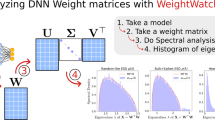Abstract
The article deals with a new criterion (the wave criterion) of estimating the generalizing ability of a neural network. The theoretical grounding of the criterion is based on Bayes theorem, the methods of cybernetics and synergy. The computing experiments carried out with the databases Fmtrain, Matt, Grng, Ada have proved the criterion to be an effective tool.
Similar content being viewed by others
References
Lawrence, S., Lee, C., and Tsoi, C., Lessons in Neural Network Training: Overfitting May be Harder than Expected, Proceedings of the Fourteenth National Conference on Artificial Intelligence, AAAI-97 (Menlo Park, 1997), California: AAAI Press, pp. 540–545.
Anderson, D., Burnham, K., and Thompson, W., Null Hypothesis Testing: Problems, Prevalence, and an Alternative, Journal of Wildlife Management, 2000, vol. 64, no. 4, pp. 912–923.
Vapnik, V., The Nature of Statistical Learning Theory, Springer, 1995.
Akaike, H., Information Theory and an Extension of the Maximum Likelihood Principle, Proceeding of 2nd International Symposium on Information Theory Budapest: Akademia Kiado, 1973, pp. 267–281.
Rissanen, J., Modeling by Shortest Data Description, Automatica, 1978, vol. 14, pp. 465–471.
Prigogine, I.R., Arising from the Existing to: the Time and Complexity in the Natural Sciences, M.: University Press, 1985.
Potapov, A.S., Recognition of Images and Machine Perception: The General Approach Based on the Principle of Minimum Length Description, St. Petersburg: Polytechnique, 2007.
Gorban, A.N., Dunin-Barkowski, V.L., Kirdin, A.N., et al., Neuroinformatics, Novosibirsk: Science. Siberian Enterprise RAS, 1998.
Besekersky, V.A. and Popov, E.P., The Theory of Automatic Adjustment, M.: University Press, 1975.
Sekerin, A.B., The Method of Assessing the Sustainability Neyronno—Network Models./2005. http://zhurnal.ape.relarn.ru/articles/2005/031.pdf.
Kobozev, N.I., Research for the Thermodynamics of Information and Thinking, Moscow: Moscow State University, 1971.
Beloglazov, V.V. and Biryuk, N.D., Analysis of the Stability of Parametric Method of Lyapunov Second Circuit, Voronezh. VSU Bulletin, Series Physics, Mathematics, 2003, no. 1.
Sibert, U.M., Chains Signals System, Moscow: Mir, 1988.
Author information
Authors and Affiliations
Corresponding author
About this article
Cite this article
Larko, A.A. Performance criterion of neural networks learning. Opt. Mem. Neural Networks 17, 208–219 (2008). https://doi.org/10.3103/S1060992X08030041
Received:
Accepted:
Published:
Issue Date:
DOI: https://doi.org/10.3103/S1060992X08030041




